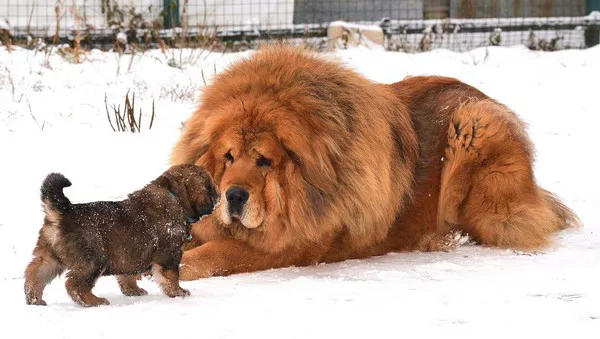Tibetan Mastiffs have captured the fascination of dog enthusiasts worldwide with their regal presence and imposing stature. But just how large do these majestic canines grow? In this exploration, we’ll delve into the dimensions that define Tibetan Mastiffs’ size, shedding light on their height, weight, and the factors that contribute to their impressive proportions.
1. Stature and Dimensions
Tibetan Mastiffs, known for their impressive size, can grow to be substantial canines. On average, a fully grown Tibetan Mastiff stands between 24 to 30 inches in height at the shoulder. This measurement accounts for the dog’s standing height and serves as a reference point for their stature.
2. Weight Range
When it comes to weight, Tibetan Mastiffs exhibit a broad range, reflective of individual differences and variations within the breed. Typically, a mature Tibetan Mastiff can weigh anywhere from 70 to 150 pounds. This wide weight spectrum is influenced by genetics, gender, diet, exercise, and overall health.
3. Factors Influencing Size
Several factors contribute to the size of a Tibetan Mastiff:
Genetics: Ancestry plays a significant role in determining a Tibetan Mastiff’s size. Responsible breeders select dogs with desirable traits to maintain breed standards.
Gender: Male Tibetan Mastiffs tend to be larger and heavier than females. Males often fall toward the higher end of the height and weight ranges.
Nutrition: Proper nutrition during a dog’s growth stages impacts its size. Puppies require a balanced diet to support healthy development.
Exercise: Adequate exercise during a Tibetan Mastiff’s early years promotes muscle growth and overall well-being.
Health: Health conditions can influence growth. Regular veterinary care ensures any health issues are addressed promptly.
4. Growth Phases
Like all dogs, Tibetan Mastiffs experience distinct growth phases:
Puppy Phase: During the puppy phase, Tibetan Mastiffs experience rapid growth. A well-balanced diet and appropriate exercise are crucial to ensure healthy bone and muscle development.
Adolescence: As puppies transition into adolescence, their growth rate slows down, but they continue to gain muscle mass and bone density.
Maturity: Around 18 to 24 months, Tibetan Mastiffs typically reach their full height. Weight may continue to fluctuate during this time.
5. Celebrating Their Grandeur
The impressive size of Tibetan Mastiffs contributes to their allure and unique charm. Their stature, combined with their dense double coat and distinct lion-like mane, adds to their regal appearance. This breed’s size aligns with its historical role as a guardian of livestock and protector of humans.
Conclusion: A Symbol of Majesty
In the realm of canines, Tibetan Mastiffs stand as living monuments to grandeur and history. Their size, varying within the established ranges, is a testament to their distinct breed characteristics and the roles they have played throughout the ages. As you contemplate the idea of welcoming a Tibetan Mastiff into your life, remember that their size encompasses a legacy of guardianship, companionship, and the enduring bond between humans and their four-legged friends.
FAQs about Tibetan Mastiffs:
Q1: How big do Tibetan Mastiffs get on average?
A1: Tibetan Mastiffs typically stand between 24 to 30 inches in height at the shoulder. Their weight can vary widely, ranging from 70 to 150 pounds. These size ranges reflect individual differences, genetics, gender, nutrition, exercise, and overall health.
Q2: Do male and female Tibetan Mastiffs differ in size?
A2: Yes, male Tibetan Mastiffs are generally larger and heavier than females. Males often fall toward the higher end of the height and weight ranges. Female Tibetan Mastiffs tend to be smaller in comparison.
Q3: How does nutrition impact the size of Tibetan Mastiffs?
A3: Nutrition plays a crucial role in a Tibetan Mastiff’s growth and development. Puppies require a well-balanced diet with appropriate nutrients to support healthy bone and muscle growth. A high-quality diet during growth stages contributes to achieving their full potential size.
Q4: Can exercise affect a Tibetan Mastiff’s size?
A4: Yes, exercise is important for a Tibetan Mastiff’s overall health and development. Adequate exercise during the puppy and adolescent phases promotes muscle growth and bone strength. However, excessive exercise during the growing stages can potentially impact their joint health, so it’s important to strike a balance.
Q5: When do Tibetan Mastiffs reach their full size?
A5: Tibetan Mastiffs typically reach their full height at around 18 to 24 months of age. During this time, they transition from adolescence to maturity. While height stabilizes, weight may continue to fluctuate as they develop muscle mass and body composition.
Q6: How does the size of Tibetan Mastiffs relate to their historical role?
A6: The size of Tibetan Mastiffs aligns with their historical role as guardians of livestock and protectors of humans in the Himalayan regions. Their imposing stature and protective instincts were essential for effectively warding off predators and safeguarding their charges.
Q7: Are there health considerations related to the size of Tibetan Mastiffs?
A7: While Tibetan Mastiffs are generally robust dogs, their size can contribute to certain health considerations, such as joint issues. Responsible breeding practices, proper nutrition, and regular veterinary care help mitigate potential health risks.
Q8: Can I predict how big my Tibetan Mastiff puppy will become?
A8: While you can estimate your puppy’s potential size based on breed standards and parental size, individual variations and genetics play a role. Consult with responsible breeders and veterinarians for guidance on predicting your puppy’s growth trajectory.
Q9: How can I ensure my Tibetan Mastiff grows to its full potential size?
A9: Providing a balanced and nutritious diet, regular exercise appropriate for their age, and consistent veterinary care are key to ensuring your Tibetan Mastiff reaches its full potential size in a healthy and controlled manner.
Q10: Are Tibetan Mastiffs suitable for smaller living spaces due to their size?
A10: While Tibetan Mastiffs are large dogs, their suitability for smaller living spaces depends on their exercise needs, training, and your commitment to meeting their requirements. Adequate exercise and mental stimulation are essential regardless of the living space.


